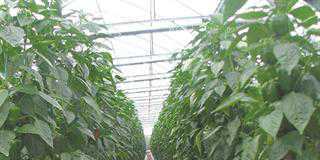
Most arable soil around the world has been deficient in sulphur (S) for over three decades, but the negative effects on global crop production has only recently become evident according to Dr Elke Bloem, a scientific director at Germany’s Julius Kühn-Institut (JKI). This federal research centre specialising in commercial crop production research has been conducting extensive investigations into the value of S as a plant nutrient for more than 30 years.
“Scientists discovered that since the early 1980s, Germany began experiencing a gradual decline in the S levels in its arable soil,” Bloem explains. “However, it still took about 20 years before German farmers began adding S to soil on a regular basis. This delay in making S applications part of a farm’s regular fertilisation programme was because S was readily available in arable soil prior to that, due to high levels of S emissions from factory smokestacks and diesel-powered engines.”
The problem with these S emissions was that, by about 1970, Europe began experiencing the effects of acid rain. This occurs when nitric and sulphuric acid gases react in the atmosphere with water, oxygen, and other chemicals to form various acidic compounds. When these compounds are blown into areas with wet weather, they can fall to the ground in the form of rain, snow, fog or mist.
Acid rain fallout
Among its many negative consequences, acid rain was responsible for large swathes of Europe’s indigenous forests dying off, as well as polluting freshwater resources causing the death of huge numbers of fish. In response, Europe enacted legislation to significantly curb S emissions in the 1980s and much of the rest of the world soon followed. This, however, led to S levels in arable soils decreasing.
Putting sulphur back
Increasingly, scientific research indicates that crop farmers will have to start applying S through fertilisation to achieve optimal production from ever-improving, high-performance crop genetics. Scientists have determined that S, along with nitrogen (N), phosphorous (P) and potassium (K), is an essential nutrient for plant growth and nutrition. Plants primarily take it up via their roots in the form of sulphate. To a much lesser extent, plants also absorb S from the atmosphere in the form of sulphur dioxide, carbonyl sulphide, and hydrogen sulphide.
Plants need S for the production of amino acids, such as cysteine, methionine, tripeptide and glutathione. S is also found in enzymes, vitamins, and secondary compounds in plants, and is a key ingredient in chlorophyll. S even influences the colour and fragrance of flowers which, in turn, are important for attracting pollinating insects and repelling insect pests. S can have a profound impact on crop yield and can alter the taste and smell of foodstuffs, such as garlic and onions.
“Oilseed rape is one of the crops with a high demand for S, and S-deficiency has been known to result in oilseed rape yield losses of up to 70%,” says Bloem.
“S is also very important for crop quality. Winter wheat deficient in S has been shown to result in poor quality baking flour, leading to poor quality loaves of bread.”
She adds that plants use S and N jointly to biosynthesise amino acids and to synthesise proteins. So, if plants do not have sufficient levels of S, their N content cannot be effectively utilised. On average, for each kilogram of S deficiency in a plant, 10kg to 15kg of applied N fertiliser could be lost into the environment.
This N loss is not only physically and financially wasteful, but detrimental to the natural environment and freshwater resources.
Bloem points out that as far back as 1873, German chemist Justus von Liebig found that the nutritional status of plants was one of the key factors regulating their susceptibility to disease. It is now known that S and S-based compounds are beneficial for fighting plant diseases. For example, elemental S has a fungicidal effect, carbon disulphide (CS2) can be used as a soil fumigant against soil-borne fungi, and sulphur dioxide (SO2) is effective as a post-harvest preservative for dried fruit, vegetables, spices, grains and wine in barrels. It also contributes to sulphur-induced resistance to a number of diseases and pests.
Sulphur status
“The different options available to identify the S-status of crops in a field are visual diagnosis, soil analysis, plant analysis, calculating the difference between applied S and remaining S after harvesting, and scientific modelling of the S supply,” Bloem explains.
For visual diagnosis of a crop’s S-status, Bloem recommends that an expert be consulted. Plants with a shortage of S show symptoms such as marbling of leaves, making them dark green along the veins but noticeably lighter across the rest of the leaf. The leaves can also be disfigured and show reddening around the edges.
In the case of oilseed crops, S deficiency can manifest in below-average-sized seed pods containing a below-average number of seeds.
Diagnosis in grains
In the case of grains, diagnosing S-deficiency visually can be difficult because it can be misdiagnosed as N-deficiency. The younger parts of the plants will be lighter green when S-deficient, while the older parts of the plant will be lighter green when N-deficient.
“In Germany, we take soil samples at a depth of 60cm and analyse them for plant-available sulphate,” explains Bloem. “It’s important that a soil analysis for S levels is able to extract as much plant-available S as possible to achieve the most accurate results and S application recommendations. “A problem with soil analysis for S, though, is that the results often quickly become irrelevant because S is very mobile in the soil from day to day, and also shows a high spatial variability in fields.”
Ratios difficult to analyse
Plant analysis can provide highly accurate figures for total S present in the plant. However, for determining a plant’s N:S ratio, sulphate levels and glutathione levels, the plant analysis method can be less meaningful. Bloem explains that when conducting an analysis for different S levels in a plant, one should always remember that critical nutrient levels will vary depending on factors such as the plant’s growth stage at sampling, the plant part being sampled, and the productivity and quality characteristics of the specific crop being analysed.
It is recommended that when analysing a plant for S, the sample should always be taken at the plant’s main growth stage because this allows the farmer to easily observe the differences between plants with healthy S levels and those in the same land that are S-deficient. However, applying pesticides containing S can lead to false readings in plant analyses, says Bloem.
Although calculating a field’s S input and output balances can be an effective tool, this is difficult to achieve due to the large number of factors that must be taken into account. These include S deposited from the atmosphere, fertilisation and irrigation, the movement of S via groundwater and leaching, losses of gaseous S from the soil, and crops’ utilisation of S in the soil.
Extensive surveys are needed to determine results. In Germany, modelling the S supply has been found to be the most feasible and effective means to measure S requirements, Bloem says. Fertiliser manufacturers have also developed questionnaires to gather basic information from farmers. These serve as a points-based system that is used to recommend S levels in fertiliser.
The S inputs from groundwater and irrigation are also factored in when calculating S fertiliser quantities. South Africa, like Europe, has access to a large variety of S-based fertilisers to address S-deficiencies. If only S is required, an elemental S product can be used. However, when applying elemental S, it is important to remember that plants can only take up S from the soil in the form of sulphate. Thiobacillus soil microorganisms oxidise elemental S into sulphate.
Soil lacking Thiobacillus microorganisms when elemental S is applied, can take weeks before the plants start benefiting from the application. “If you want a speedily available S supply for your crop, you should use fertilisers that contain sulphate,” stresses Bloem. “This can be ammonium sulphate, potassium sulphate or superphosphate, among others. There is very little risk of negative effects from over-applying S because, in most cases, any excess simply leaches down into the soil profile.”
Manure as sulphur source
Livestock manure can also be utilised as a source of S for crops. Ideally, it should be analysed for its mineral content before being applied. As a rule of thumb, every 1kg N applied to soil using livestock manure, adds 0,07kg S to the soil, says Bloem. S can be applied to plants both through the soil and via foliar application. If it is done through the soil, the S application must be high enough to satisfy the demand of the particular crop.
For standing crops with S-deficiency, it should be applied via foliar sprays as a complementary measure. An advantage of foliar applications is that plants utilise it very effectively.
Email Dr Elke Bloem at [email protected].
This presentation was made at the Omnia Farmers’ Information Day in Hilton, KwaZulu-Natal.












